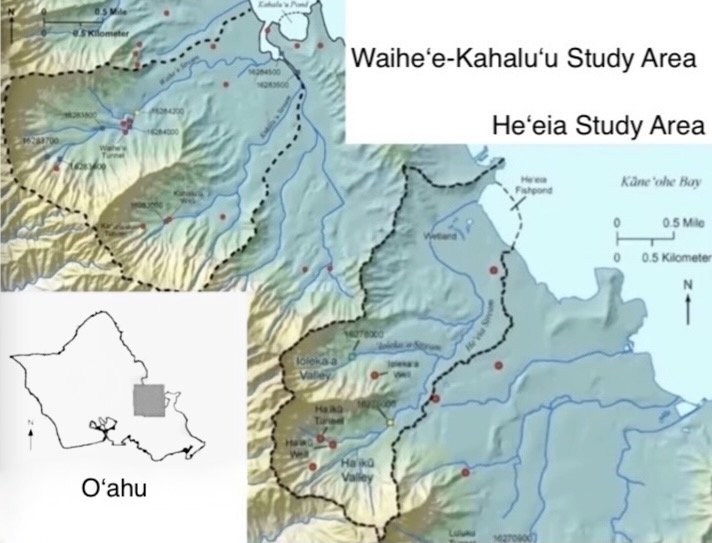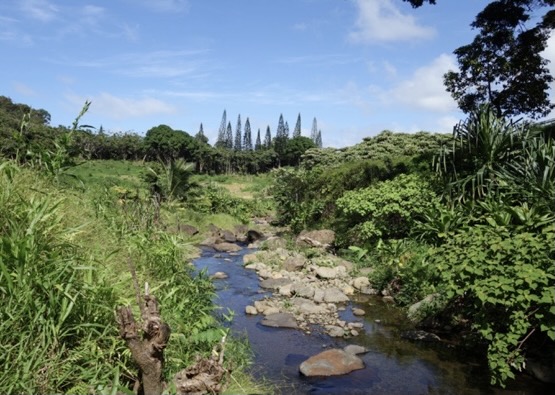Preliminary groundwater modeling results from the U.S. Geological Survey seem to support what staff with the Commission on Water Resource Management believed when they proposed new interim instream flow standards (IIFS) for He`eia Stream in Windward Oʻahu more than a year ago: That withdrawals from the Honolulu Board of Water Supply’s (BWS) tunnels and wells in the area were reducing base flow in that stream and others.
At the Water Commission’s April 19 meeting, Barry Usagawa, program administrator for the BWS’s Water Resources Division, didn’t exactly contest the USGS findings, which were reached using an admittedly coarse model. But he did urge the commission to consider water quality, not just quantity, in deciding whether or not to further restrict the BWS’s groundwater withdrawals in the region to meet protected public trust uses.
Contaminants from cesspools and former military training sites may be polluting whatever water is returned to He`eia Stream, he suggested.
“We are in a water shortage situation because of Red Hill on the town side,” he said, referring to the groundwater contamination caused by fuel spills from the U.S. Navy’s bulk storage facility.
“Any further cutbacks in Kahaluʻu-Waiheʻe — they’re our primary water supply for Kāneʻohe, Kailua and Waimānalo — could create a water shortage condition there, too,” he said, reminding the commission that domestic water use is also a public trust use. (The total combined population of Kāneʻohe, Kailua and Waimānalo exceeds 76,000.)
Bulkhead
In the fall of 2020, commission staff proposed a new IIFS of 1.77 million gallons a day for He`eia Stream. Stream users, including non-profit groups involved in restoring and maintaining an ancient Hawaiian fishpond and nearby agricultural fields, had complained about inadequate flow. Commission hydrologist Ayron Strauch, who had studied the relationship between groundwater withdrawals and stream flow in the area, said last year that flows into He`eia dropped to a trickle — 300,000 gallons a day — in the dry season.
Last June, the Water Commission ordered the BWS to reduce its withdrawals from a tunnel in Haʻikū to 0.3 million gallons a day, in the hope that that would increase stream flow.
Under the same commission order, the BWS must complete by June 2023 a feasibility study and preliminary engineering design of a 10-foot-thick bulkhead 1,200 feet inside its Haʻikū Valley tunnel. The bulkhead, which would keep more of the water inside the mountain, is intended to result in more base flow in He`eia Stream.
In recommending the new bulkhead, commission staff noted that the “substantial ecological and cultural values supported by He‘eia Stream, including habitat for native amphidromous species, restored native riparian environment, a healthy estuarine and near-shore ecosystem, recreational and aesthetic values, as well as the productivity of the He‘eia fishpond and wetland to support a biocultural food production system, merits restoration of He‘eia Stream to pre-tunnel baseflow. …
“Such action would increase spring flow in Ha‘ikū while providing a more reliable source of water supply for HBWS. This solution is expected to increase the natural capacity of the high-elevation groundwater system to store and discharge water to streams and springs in the moku of Ko‘olaupoko.”
If the BWS determines that constructing the bulkhead is feasible, it has three years to complete construction. Commission staff will then “evaluate the resultant effects on stream baseflow and may amend the interim IFS or amend the HBWS water use permit as needed.”
If the BWS finds a new bulkhead infeasible, commission staff will recommend a new IIFS or amend the BWS’s water use permit as needed.
Modeling Results
At the commission’s April 19 meeting, USGS hydrologist Scot Izuka presented preliminary results from a model of the He`eia and adjacent Waiheʻe-Kahaluʻu watersheds. Izuka stressed upfront that the results were preliminary and subject to revision, and that they were also based on a model created for a different island-wide study. As a result, the model was “rather coarse” — its resolution, at 500 square feet, is much wider than a stream. It also did not factor in all of the stream reaches.

The Heʻeia watershed study was done in cooperation with the BWS, while the Waiheʻe-Kahaluʻu study was done in cooperation with the Water Commission.
Izuka presented maps showing the effects of BWS groundwater wells and tunnels in Haʻikū, Kahaluʻu and Waiheʻe, six sources in total.
The map for Haʻikū tunnel, which was assumed to have withdrawals of 0.53 mgd, showed that the tunnel lowers groundwater levels by at least two feet beyond the immediate watershed.
The tunnel also reduced stream flow not just in He`eia, but in Kahaluʻu and “all the way to Waiheʻe, probably even farther,” he said.
The stories for the other five sources were the same: the effects of BWS withdrawals on groundwater and stream flow extended well beyond the immediate watersheds, even as far as the leeward side of the island.
Water does not care about topography, but follows the path of least resistance, Izuka explained.
When looking at the effect of all six sources, the area impacted was much larger. A total of about 5 mgd was estimated to be withdrawn from the three tunnels, and 1.67 mgd came from the three wells. Those withdrawals resulted in a reduction in stream flow of 3.19 mgd in the Waiheʻe – Kahaluʻu watershed.
He said the results were not “earth-breaking news,” since it was always known the withdrawals would affect stream flow. However, the USGS studies have gone a long way toward quantifying those effects.
Water Quality
After Izuka’s presentation, commissioner Mike Buck asked how the USGS results might inform the commission’s decisions on IIFS.
While Izuka sidestepped the question, Dean Uyeno, head of the commission’s stream protection and management branch, said that the USGS work supports a lot of the work Strauch had already done.
Strauch added, “We will be developing IFS, understanding that it’s pretty much a one-to-one relationship.” He said that the commission would be using the information from the USGS studies “as we move forward across Windward O’ahu. We’re still digesting the data for now. But yes, we are definitely moving forward on using this.”
Usagawa of the BWS seemed concerned that the study results would be used to justify further reduction in withdrawals from the tunnels and wells.
He questioned the confidence with which management decisions could be made based on information from a coarse model that did not account for individual dikes.
To conserve water, he also asked whether there was a way to pipe some of the water in He`eia Stream to the lo`i kalo being farmed near the fishpond, rather than letting it flow into the wetland. “The conveyance system should be looked at for losses in addition to cutting us back more,” he said.
“Lastly, I was wondering if the study … would look at water quality, not only quantity,” he said.
He noted that the Kahaluʻu estuary is “one of the most cesspool-polluted estuaries on the island,” with 740 cesspools in the area, he said.
“If you’re restoring [land] for farming, the Food Safety Modernization Act lays a lot of food safety conditions on farmers. … Would you eat leafy vegetables if it was irrigated with cesspool-contaminated water is my question. I was wondering if at least that would be mentioned in the study or not,” he said.
He added that in the course of conducting an environmental impact statement for a proposed learning center in Waiheʻe, the BWS discovered that part of the Waiheʻe Valley and the neighboring Ka`alaea Valley had unexploded ordnance from the time the area was used for target practice during World War II. He said testing by the federal government found 19,000 mg/L of lead, as well as arsenic and the explosive contaminant RDX.
“That contamination affects farming, to me. If you’re only taking two samples and the two are positive and are that high, there are some public health issues there,” he said. He added that the BWS has talked to the Army Corps of Engineers and U.S. Rep. Kai Kahele about the possibility of remediating the ordnance sites.
“Unfortunately, there’s a ton of these sites around the world they need to remediate, but I think that needs to happen before we can think about how much water we can return to the stream to promote agriculture when the water and the soils are contaminated,” he said.
In any event, the BWS would continue to work with the community and government agencies toward a balanced solution, he said. One possible solution may be pumping a well on land near the state hospital in Kāneʻohe.
Commission chair Suzanne Case asked Izuka whether closing a tunnel would increase storage capability in the dikes it taps and increase stream flows on a broader basis.
“Theoretically, yes,” Izuka said, adding that it would depend on how the tunnel was closed.
“Bulkheads are usually built at a dike. So if you were to restore it completely to its natural condition, plug up the dikes, it would depend on climate. Climate is a little different from what it was in the 1940s. It may take a little bit longer to restore, but, theoretically, it would restore,” he said.
He noted that given the evidence indicating that the tunnels and wells are affecting streams outside the valleys in which they occur, plugging tunnels would restore water to all of the streams from whence it came.
“Just using Haʻikū tunnel as a mental experiment, if you were to plug that up and the head would build up, it would restore some of the flow in He`eia Stream,” he said, noting that some would go to Ioleka`a Stream and as far away as Kahaluʻu Stream.
(For more background on issue, see, “Commission Pressures BWS to Meet Proposed Heʻeia Stream Flow Standards,” from our March 2021 issue, and “Water Commission Orders Honolulu BWS To Take Steps to Restore He‘eia Stream,” from our July 2021 issue. Both are available on our website, www.environment-hawaii.org.)
— Teresa Dawson


Leave a Reply